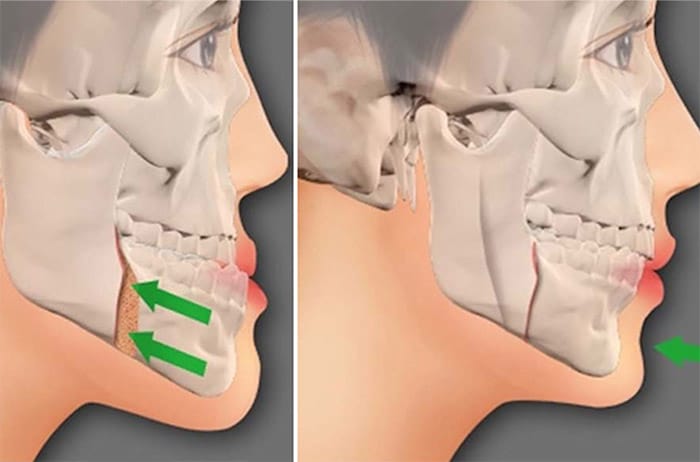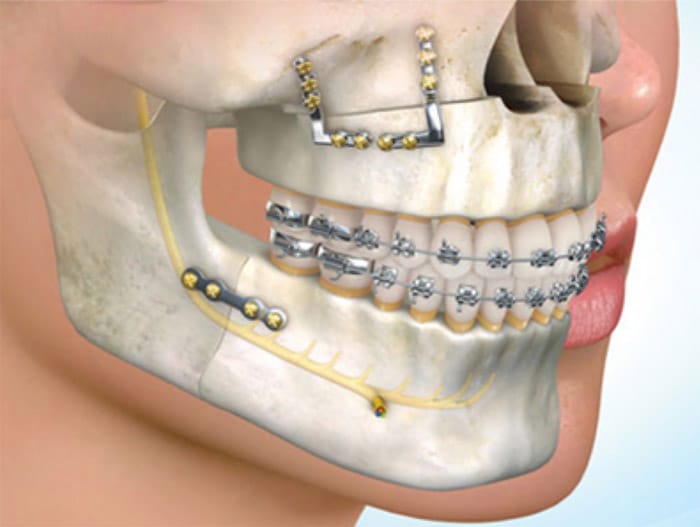Orthognathic surgery by Dr. Issembert
Dr. Issembert’s introductory remarks
With dozens of patients treated each year using a combination of orthodontics and maxillofacial surgery, I offer each patient a personalized treatment adapted to their case. This type of treatment can take between 10 and 24 months, depending on the case – on average, 18 months of treatment are required.
The decision for the patient to have surgery associated with his orthodontic treatment is actually relatively simple, because once enlightened by the first consultation, the idea that it was something complicated, painful and risky, disappears. In fact, because of our wide clinical exposure, we are able to show pictures of many patients who have already been treated in the same way, and we are also able to explain to them how the patients feel after the surgery.
Jaw surgery
WHAT IS ORTHOGNATHIC SURGERY AND WHEN SHOULD IT BE CONSIDERED?
Orthognathic surgery is a surgery that aims to correct the position of the jaws. It is a part of maxillofacial surgery.
These deformities normally cause obvious aesthetic problems, but they can also be problematic in daily life for eating, speaking, drinking or even breathing. When orthodontics is no longer sufficient, jaw surgery should be considered. This orthognathic surgery, performed by a maxillofacial surgeon in Paris, allows for a total repositioning of the teeth.
When the patient comes to us with such complaints before or after the diagnosis is made, we explain the treatment plan to the patient, including this surgery, which usually occurs within 6 to 12 months of the start of treatment.
Once the orthodontist has finished aligning the teeth for this surgery, the patient goes to the maxillofacial surgeon, who schedules a surgery date after analyzing some additional radiological and clinical data. This transition is very smooth. In the month following surgery, the patient continues with orthodontic treatment, which is usually completed within 6 months. Depending on the procedure, the patient is seen again within 2 to 6 weeks by the orthodontist.
How to prepare for the operation? What does it consist of? How much does it cost, or what are the post-operative consequences? Find out everything there is to know about jaw surgery.




What does a maxillofacial surgeon do?
This type of surgical specialization involves the maxilla and mandible (i.e., jaw bones), face, mouth and teeth. Originally, maxillofacial surgery was created to treat soldiers called “broken jaw” during the war. Today, this specialty has been democratized and is used to treat all kinds of problems, aesthetic or not.

Here is an overview:
- Bone trauma (mandible, nose bones, facial fractures, etc.) and soft tissue trauma
- Benign and malignant tumors, the maxillofacial surgery specialist is qualified to remove tumors of the face and will also perform the reconstruction that follows.
- Malformative pathologies
- Reconstruction and reanimation of the face, for example after facial paralysis or skin grafting
- Orthognathic surgery, i.e. everything that concerns the morphological anomalies of the bones and joints of the jaw
- Cosmetic surgery of the face as well as the correction of traumatic after-effects, the surgeon can therefore perform rhinoplasties, face lifts, take back scars on the face, etc.
- Implant and pre-implant surgery, i.e. bone grafting or osteotomies prior to the placement of dental implants for example
- Orbito-palpebral surgery, i.e. everything in the eye and eyelid area
- Salivary glands
- Temporomandibular joint pathologies
- Teeth and cysts of the maxilla (upper jaw bone) and mandible (lower jaw bone)
- Stomatology, a discipline that corresponds to the study and treatment of pathologies related to the oral cavity
The maxillofacial surgery specialist therefore has a wide range of knowledge and a complete vision of how the mouth, teeth, jaw and face function.
Why have jaw surgery?
The causes of jaw malformations are very varied. First of all, it is important to know that the jaw is articulated in two parts: at the top, there is the maxilla, which belongs to the face, and at the bottom, the mandible which has a horizontal and vertical branch and is L-shaped.
There are many causes that can lead to maxillofacial surgery. When you come in for a consultation, we are here to guide you through the different possibilities. However, to give you a better understanding of the subject, here is a list of the most common causes:
YOUR JAW IS NOT POSITIONED CORRECTLY
The most common jaw deformities are: prognathia, when the mandible (lower jaw) is too far forward in relation to the maxilla (upper jaw), and, conversely, retrognathia, when the mandible is too far back (lower jaw). There is also the gingival smile and the narrowness of the upper jaw.
These problems of malpositioned jaws lead to a bad occlusion, because the teeth do not mesh correctly. People with this morphological deformity will be embarrassed aesthetically and sometimes to chew, breathe, express themselves, but usually to a much lesser degree. In this case, the orthodontist and a maxillofacial surgeon can remedy this problem by combining osteotomy and orthodontics, in other words by removing the jawbone in order to reposition it correctly.
THE PROGNATHY
When the mandibular bone is too far forward in relation to the jawbone, in other words if the chin is too far forward, we speak of prognathia. The incisors and canines are no longer well superimposed and only the upper and lower molars are in contact. This condition is usually quite unsightly and often combined with a lack of width of the upper jaw and therefore with airways so narrow that they prevent good ventilation (global hypoplasia of the maxilla).
There is also sometimes increased wear of the molars, but this is only the case when this condition is associated with bruxism. Speech may also be poor, but correction of this dismorphosis is not always accompanied by its resolution. Some patients complain of jaw pain, which is usually associated with bruxism or clenching. Surgical correction may be accompanied by resolution, but if the aesthetic result is not uncertain, the result concerning these pains is.
RETROGNATHIA
In contrast to prognathia, the mandibular bone is too far back and the chin is receding. Again, this shift is often unsightly. Some patients see this as a link to possible difficulties in speaking, chewing, as well as a link to jaw pain. In the same way, if the aesthetic correction is not random, the correction of these problems that could be qualified as more functional, is, because they are probably multi-factorial.
These two types of deformities are the most common. However, there may be other cases such as: lateral mandibular shifts, overly visible gums, a square jaw, and a combination of several of these conditions.
THE GINGIVAL SMILE
The gummy smile is most often multifactorial. It is most often a combination of the following elements :
- Excess vertical growth of the upper jaw
- Short upper lips
- Overactive levator lip muscle
- Excess gum tissue
- Maxillofacial surgery will impact the upper jaw and reduce the hyperactivity of the levator muscle of the upper lip
- For a short lip, an incision of the latter, called VY, allows to lengthen it within a certain limit
- Finally, excess gum tissue can be managed by a periodontist, who would perform a gingivectomy possibly associated with a bone plasty
ETROITNESS OF THE MAXILLA
The narrowness of the maxilla is materialized by the upper posterior teeth inside the lower teeth. This condition is called a uni or bi-lateral cross bite. In this case, the surgeon performs an operation called a maxillary disjunction. This is a 30-minute procedure that consists of breaking the platinum suture with intraoral access. This procedure is not painful. It requires the orthodontist to place an extension appliance beforehand. One week after the procedure, the patient will have to activate the appliance once a day for 40 days. This will create a space between the two central incisors that will be closed in a second phase with braces, ceramic braces or Invisalign aligners.

YOU SUFFER FROM SLEEP APNEA
Contrary to what most people may think, sleep apnea is a disorder that should not be taken lightly. In fact, it can be associated with serious cardiorespiratory problems. The retrognathia mentioned above can be an aggravating factor in sleep apnea. It is possible to reduce this apnea by advancing a mandible and/or widening a maxilla.
YOU HAVE MISSING TEETH
Are you missing one or more teeth due to an accident or simply because they never grew? It is possible to place dental implants.
YOUR WISDOM TEETH ARE HURTING YOU
Wisdom teeth, once they have grown in your jaw, can often be a source of discomfort and pain. They are farther away in the jaw and are more prone to cavities and infections. If your jaw does not have enough room to accommodate wisdom teeth, they become trapped in the gums. It is then possible to extract these cumbersome teeth.
What is jaw surgery?
This type of orthognathic surgery, performed under total anesthesia, will require orthodontic preparation beforehand. The orthodontist will first use Invisalign aligners, lingual treatment or ceramic braces to align the teeth and prepare the dentition for the jaw surgery.
- First, he will cut the mucous membrane to expose the mandibular bone.
- Once the bone has been cleaned of all attachments, he will then place a guide that will show him where to make the cut.
- The surgeon will then perform an osteotomy, which is the surgical cutting of the bone, following the guide.
- Finally, a custom-made, 3D-printed titanium plate will be used. This plate is less than one millimeter thick and corresponds exactly to the new anatomy of the patient’s jaw. The surgeon will then attach this plate to the jaw with screws.
- This operation will then be repeated on the jawbone, i.e. the upper jaw, to align it with the lower jaw.
This operation will then be repeated on the jawbone, i.e. the upper jaw, to align it with the lower jaw.
What happens after jaw surgery?
POSTOPERATIVE EFFECTS
Following jaw surgery, you are usually discharged the same day. During the healing process, only soft or liquid foods can be eaten to avoid altering the healing process.
The pain that will follow this procedure is very well reduced with painkillers. Patients rarely complain of pain but more of discomfort.
Most of the time, we notice the appearance of an edema, that is to say a swelling of the face after the operation. This swelling varies from person to person. Our surgeon will provide you with a cold application machine that will quickly deflate the swelling. Generally, the swelling in the face subsides within the first 72 hours following the operation.
Some bleeding may also occur, but like the swelling, it does not last very long. However, it will be essential to keep brushing your teeth carefully, even if it has become difficult. To help you, it is recommended to use a surgical toothbrush which will be much more flexible.
It is also necessary to stop smoking, which prevents the proper healing of the mucous membranes. Sports activities should also be avoided during the healing process. In a patient who has followed all the recommendations, the bone will be consolidated in about 6 weeks.
FOLLOW-UP
After jaw surgery, no rehabilitation is necessary. However, having a physiotherapist help the patient to evacuate the residual swelling more quickly and to recover his mouth opening more quickly. Thanks to these sessions, the patient will be able to speak and eat with ease.
As previously mentioned, the orthodontist will see you within two to six weeks after the procedure and will complete the treatment within six months.
Finally, it is important to know that the fixation plates and screws that were installed during the surgery do not necessarily need to be removed.
Surgery of the chin or Génioplastie
WHAT IS CHIN SURGERY FOR?
Chin surgery is most often performed for aesthetic reasons. Also called genioplasty, it is sometimes associated with various procedures performed on the mandible and the maxilla, the bones that allow the articulation of the jaws.
Some people will seek to harmonize their entire face through genioplasty, which can be forward, backward, downward, upward or a combination of several movements.


WHAT ARE THE DIFFERENT CASES REQUIRING A GENIOPLASTY ?
Genioplasty, or chin surgery, will allow the modification of the shape and position of the chin in order to rebalance the lower part of the face:
- If your chin is “receding”, i.e. too far back, an advancement genioplasty is indicated
- If your chin is too far forward, a receding genioplasty can be considered, but care must be taken to ensure that the soft tissue continues to be supported.
- When the chin is too low, too recessed and staked, it is often moved forward and upward
- When the chin is curved, i.e., it tends to meet the nose, the mandible itself is usually too far up and combined chin and mandible surgery is necessary. Since the situations are multifactorial, the patients will be analyzed clinically and radiologically in detail before deciding on surgical movements.
Following the differential diagnosis, the orthodontist will be able to identify the etiology of the prognathism or retrognathism. When this condition comes from the chin rather than the mandible or maxilla, a genioplasty is proposed.
HOW DOES THE PROCEDURE WORK?
This is an outpatient procedure. It is performed under general anesthesia and lasts about one hour. Once the patient is asleep, the surgeon will cut the mucous membrane from the inside of the mouth to gain access to the bone, and will then perform his osteotomy which he will stabilize with titanium plates and screws. You can then go home with a cold mask to limit swelling and a prescription for painkillers.
RESULTS AND POSTOPERATIVE EFFECTS
Following this chin operation, you will go home the same day. The application of a cold mask will reduce the swelling that appears in the hours following the operation. Don’t worry, it is not serious and will subside. The pain will be erased thanks to painkillers.
In some cases, antibiotics may be prescribed.
There is no dietary constraint, but it is easier to eat soft and cold things. These minor inconveniences are largely compensated by the aesthetic improvement of the face. Bone consolidation lasts an average of one and a half months.







